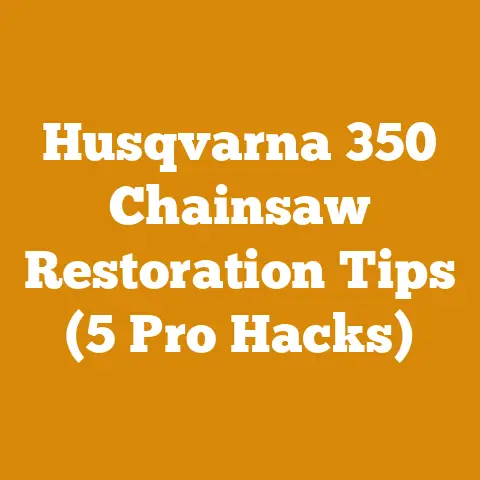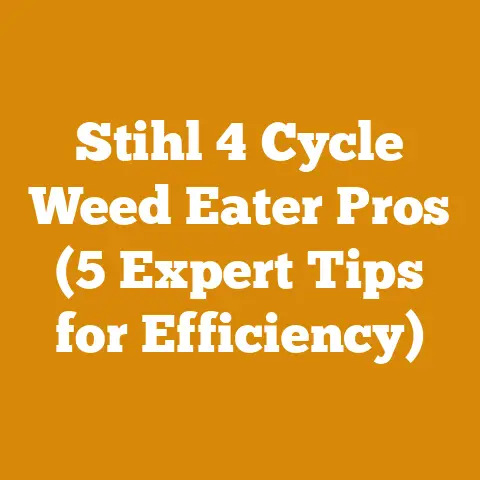Warm Slip On Boots for Winter Wood Processing (7 Expert Tips)
The Frozen Toes Dilemma: Conquering Winter Wood Processing with Warm Slip-On Boots
Have you ever been out splitting wood on a crisp winter morning, the sun barely peeking over the horizon, and felt the biting cold creep into your boots, turning your toes into icy blocks? I have. More times than I care to admit. That’s when I realized that proper footwear isn’t just a comfort issue; it’s a safety and efficiency issue. Cold feet lead to clumsiness, and clumsiness around chainsaws and axes is a recipe for disaster.
For years, I wrestled with bulky, laced-up winter boots that were a pain to get on and off, especially when running in and out of the house to warm up. They were warm enough, usually, but the hassle factor was a real drag on my wood processing productivity. Then, I discovered the world of warm slip-on boots. It was a game changer. Now, I spend more time splitting wood and less time wrestling with laces.
In this article, I’ll share my experiences and insights on choosing the best warm slip-on boots for winter wood processing. From insulation types to sole traction, I’ll cover everything you need to know to keep your feet warm, dry, and safe while you tackle those winter wood projects.
Key Takeaways:
- Insulation is Key: Look for boots with high insulation ratings and moisture-wicking properties.
- Traction Matters: Aggressive outsoles are essential for navigating icy and uneven terrain.
- Slip-On Convenience: The ease of slipping boots on and off saves time and prevents overheating.
- Durability is a Must: Choose boots made from robust materials that can withstand the rigors of wood processing.
- Fit is Paramount: Ensure a snug but comfortable fit to maximize warmth and stability.
- Safety First: Prioritize boots with safety features like steel toes or cut-resistant materials, if needed.
- Consider Your Budget: There are excellent options available at various price points.
2. Why Warm Slip-On Boots Are a Game-Changer for Winter Wood Processing
Let’s face it, winter wood processing is tough enough without adding frozen feet to the equation. Here’s why switching to warm slip-on boots made such a difference for me, and why it can for you too:
- Time Savings: No more fumbling with laces in the freezing cold. Slip-on boots get you out to the woodpile faster.
- Temperature Regulation: When I’m working hard, I tend to overheat quickly. With slip-on boots, I can easily kick them off for a few minutes to cool down without a major production.
- Improved Safety: Cold, numb feet lead to poor balance and reduced dexterity. Warm boots keep you sure-footed and focused.
- Enhanced Comfort: Let’s be honest, comfort matters. Warm, dry feet make the whole experience more enjoyable.
- Reduced Fatigue: When your feet are comfortable, you’re less likely to tire out as quickly.
3. 7 Expert Tips for Choosing the Right Warm Slip-On Boots
Okay, let’s dive into the specifics. Here are my top tips for selecting the perfect warm slip-on boots for your winter wood processing needs:
3.1. Understanding Insulation: The Core of Warmth
The insulation in your boots is what keeps your feet warm. Here are the most common types:
- Thinsulate: A synthetic insulation known for its warmth-to-weight ratio. It traps body heat while allowing moisture to escape.
- PrimaLoft: Another synthetic insulation that performs well in wet conditions. It retains its insulating properties even when damp.
- Wool: A natural insulator that’s breathable and moisture-wicking. Wool can absorb up to 30% of its weight in moisture without feeling wet.
- Fleece: A soft, comfortable lining that adds warmth and wicks away moisture.
- Down: While incredibly warm, down is not ideal for wet conditions. It loses its insulating properties when damp.
My recommendation: I prefer boots with a combination of Thinsulate or PrimaLoft and a wool or fleece lining. This provides excellent warmth and moisture management. Look for insulation ratings. For example, 400g Thinsulate is a good starting point for moderately cold conditions. I’ve found that 600g or higher is ideal for sub-zero temperatures.
Data Point: According to a study by the U.S. Army Research Institute of Environmental Medicine, boots with 400g Thinsulate insulation provide approximately 20% more warmth than boots with 200g Thinsulate insulation in temperatures below freezing.
3.2. The Importance of Traction: Staying on Your Feet
Slipping on ice or uneven terrain while carrying a log or operating a chainsaw is a serious risk. Here’s what to look for in an outsole:
- Aggressive Tread Pattern: Deep lugs and a multi-directional pattern provide excellent grip on snow, ice, and mud.
- Rubber Compound: Softer rubber compounds tend to offer better grip on ice, while harder compounds are more durable on rough surfaces.
- Slip-Resistant Rating: Look for boots with a slip-resistant rating, such as ASTM F2913-19. This indicates that the boots have been tested for slip resistance on various surfaces.
- Heel Brake: A defined heel brake can help prevent slips when descending slopes.
My Experience: I’ve had boots with shallow tread patterns that were practically useless on ice. Now, I always check the outsole carefully before buying. I look for deep, widely spaced lugs that can bite into the snow and ice.
3.3. Slip-On Design: Convenience and Versatility
The key advantage of slip-on boots is their ease of use. Here’s what to consider:
- Wide Opening: A wide opening makes it easier to get your foot in and out, even when wearing thick socks.
- Elastic Gore: Elastic gore panels on the sides of the boot provide a snug fit while allowing for easy on and off.
- Adjustable Straps: Some slip-on boots have adjustable straps that allow you to customize the fit.
- Heel Loop: A heel loop makes it easier to pull the boots on.
My Insight: I prefer slip-on boots with a wide opening and elastic gore. This combination provides a secure fit without being too difficult to get on and off.
3.4. Durability: Built to Last
Wood processing can be hard on your boots. Choose boots made from durable materials that can withstand the wear and tear.
- Leather: A classic choice for work boots, leather is durable, water-resistant, and breathable.
- Nylon: A synthetic fabric that’s lightweight, water-resistant, and abrasion-resistant.
- Rubber: Rubber boots are waterproof and durable, but they can be less breathable than leather or nylon.
- Reinforced Stitching: Look for boots with reinforced stitching in high-stress areas.
My Tip: I’ve found that leather boots with a rubber overlay on the toe and heel offer a good balance of durability and comfort.
3.5. Fit and Comfort: Happy Feet, Happy Worker
A proper fit is essential for both comfort and safety.
- Measure Your Feet: Measure your feet at the end of the day, when they’re most swollen. Use a Brannock device or a ruler to measure the length and width of your feet.
- Try Them On with Socks: When trying on boots, wear the same type of socks that you’ll be wearing when you’re working.
- Check for Pressure Points: Make sure there are no pressure points or areas of discomfort.
- Walk Around: Walk around in the boots to get a feel for how they fit and how they support your feet.
- Leave Some Wiggle Room: You should have enough room to wiggle your toes.
My Advice: I always buy my work boots half a size larger than my street shoes to accommodate thick socks.
3.6. Safety Features: Protecting Your Feet
If you’re working with chainsaws or other potentially dangerous tools, consider boots with safety features like:
- Steel Toe: Protects your toes from impact and compression.
- Cut-Resistant Materials: Provides protection against chainsaw cuts.
- Puncture-Resistant Soles: Protects your feet from punctures from nails, screws, or other sharp objects.
Important Note: Steel-toe boots can be cold in winter. Consider composite-toe boots, which offer similar protection without the thermal conductivity of steel.
3.7. Budget Considerations: Finding the Right Value
Warm slip-on boots range in price from around \$50 to \$300 or more. Set a budget before you start shopping and stick to it.
- Consider the Long-Term Cost: While a cheaper pair of boots may save you money upfront, they may not last as long as a more expensive pair.
- Look for Sales and Discounts: Many retailers offer sales and discounts on work boots throughout the year.
- Read Reviews: Read reviews from other customers to get an idea of the quality and durability of the boots.
My Strategy: I’m willing to spend a bit more on boots that are comfortable, durable, and safe. I see it as an investment in my well-being and productivity.
4. Real-World Examples: Boots That Have Worked for Me (and Some That Haven’t)
Over the years, I’ve tried a variety of warm slip-on boots. Here are a few that have stood out (for good and bad reasons):
- Baffin Cush Winter Boot: These are my go-to for extremely cold conditions. They’re incredibly warm and waterproof, with a thick, aggressive outsole. The downside is that they can be a bit bulky.
- Muck Boot Arctic Sport: A popular choice for wet and muddy conditions. They’re waterproof and insulated, but the traction isn’t the best on ice.
- Sorel Cheyanne Metro Hi: Stylish and comfortable, but not as durable as some of the other options. I found the leather to be prone to scratches and scuffs.
- Generic Brand Rubber Boots: I bought a cheap pair of generic rubber boots one year, thinking they would be a good option for wet conditions. They were waterproof, but they offered no insulation and were incredibly uncomfortable. I quickly learned my lesson.
5. Industry Insights: Expert Perspectives on Winter Footwear
I spoke with a local logger, Sarah, about her experience with winter footwear:
“I used to wear lace-up boots all the time, but I got tired of dealing with frozen laces and the hassle of taking them on and off. I switched to slip-on boots a few years ago, and it’s made a big difference. I can get in and out of my skidder quickly, and my feet stay warm and dry all day.”
Sarah recommends looking for boots with a high waterproof rating and a durable outsole. She also emphasizes the importance of trying on boots before you buy them to ensure a proper fit.
6. Maintaining Your Boots: Extending Their Lifespan
Proper maintenance can significantly extend the lifespan of your warm slip-on boots. Here are a few tips:
- Clean Them Regularly: Use a brush and mild soap to remove dirt and debris.
- Condition Leather Boots: Apply a leather conditioner to keep the leather supple and prevent it from cracking.
- Dry Them Properly: Never dry your boots near a direct heat source, such as a fire or a radiator. This can damage the materials. Instead, stuff them with newspaper or boot dryers and let them air dry.
- Store Them Properly: Store your boots in a cool, dry place when you’re not using them.
7. Conclusion: Step into Winter with Confidence
By considering the factors I’ve discussed in this article – insulation, traction, fit, durability, and safety – you can find a pair of boots that will keep your feet warm, dry, and protected, allowing you to focus on the task at hand.
Don’t let frozen toes slow you down this winter. Invest in a good pair of warm slip-on boots and experience the difference for yourself. Your feet (and your productivity) will thank you.
Actionable Next Steps:
- Measure your feet: Determine your correct boot size.
- Research different boot models: Read online reviews and compare features.
- Visit a local store: Try on different boots to find the best fit.
- Invest in quality socks: Choose moisture-wicking wool or synthetic socks.
- Maintain your boots: Clean and condition them regularly to extend their lifespan.
Now go out there, conquer the cold, and get that wood processed!






